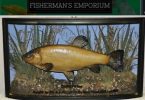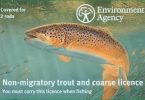Protection against Koi Herpes Virus (KHV)
Aim
The fisheries industry was been badly hit by the outbreak of Koi Herpes
Virus in 2006. This has highlighted the problems associated with new and
emergent disease and the legislative control methods that are currently in
place. This document will set out the response of the fish supply industry, as
it works towards establishing codes of practice that will help both the
industry and its customers.
We hope that this transparent approach will allow a greater degree of
trust and understanding between customer and supplier, which will allow the
industry to have much greater control over problems that may arise in the
future.
Background
Koi Herpes Virus was first officially recorded in
the
but has been found in samples of fish collected from as far back as 1996.
During the summer of 2006 it caused significant mortalities in 23 fisheries in
result the fisheries industry was badly disrupted and many fish farmers and
traders found their businesses badly affected.
Fortunately no farmers or traders were found to be infected with KHV, or
to be linked to the outbreak. Further outbreaks are likely if no action is
taken.
In the future it is likely that further “new and
emerging†diseases will appear in fish populations in
have the potential to greatly damage the fisheries industry in the
whole and the business of farmers and traders, through direct mortality, loss
of customer confidence and legislative control methods.
It is therefore in everyone’s best interest to attempt to
prevent the transfer of any pathogen, in all areas of the work carried out by
our members. By far the greatest risk of disease transfer is through direct
fish to fish contact. However, many pathogens will survive away from the host
for some time, so equipment, personnel and water will also carry risks. The
trade in live fish needs to quickly move towards adopting codes of practice
that include the principle of biosecurity.
Furthermore, the techniques used to control
infection through biosecurity and through adaptive and good husbandry practice
will allow farmers and traders to illustrate how their businesses conform to
the codes of practice for animal welfare.
Site Management Plans
A “Biosecurity planâ€
is a plan that identifies potential pathways for the introduction and spread of
disease in a zone or compartment. It describes the measures that are being, or
will be, applied to mitigate disease risks in accordance with the
recommendations in the Aquatic Code. It will also describe how these measures
are
audited, to ensure
that the risks are regularly re-assessed and the measures adjusted accordingly.
(OIE definition)
Such a plan will
obviously need to be site specific and will alter depending on the type of
trade performed at that particular site. It is therefore sensible to develop a
Site Management Plan for each site run by a business. It should be possible
to include in the Site Management Plan details of husbandry techniques and
transport protocols, thus allowing the business to show how it conforms to
other legislation, such as the Animal Welfare Bill and the Welfare of Animals
during Transport Bill.
Site Management
Plans can be used in the prevention of disease transfer. However it must be understood
that whilst the risk can be minimised in most circumstances, it can never be
completely removed. It is important therefore that their use is widely
understood and publicised. To this end we would expect there to be an easily
accessible register of businesses, which will include a summary of their Site
Management Plans. This will allow customers to make an informed choice when
purchasing their fish.
Disinfection
One of the
underpinning factors for biosecurity is effective disinfection of equipment and
personnel. Most viruses, including KHV, are inactivated by exposure to UV,
temperatures over 50oC for 1 minute or the use of a chemical
disinfectant. Viruses are generally the most resistant and so our
recommendations are as follows:
All equipment, including
personnel equipment (waders, gloves, etc.) should be cleaned and dried. The
following disinfectants can then be used although Virkon S will be the
recommended disinfectant.
|
Disinfectant |
Concentration Milligrams per |
Exposure time |
Virkon S for aquaculture
|
1% solution |
10 minutes |
|
Iodophore (Iosan CCT, |
200 |
30 seconds |
Detection
techniques for KHV and other pathogens.
The routine
examination of stock for pathogens will be a key aspect of any site management
plan. This will not only allow for reaction to the presence of a serious fish
disease, but will also allow for adaptive husbandry methods to be used to
control more normal pathogens.
Routine examination
should therefore play an active part in the management of the site. These
examinations should occur in such a way that they fulfil the husbandry
requirements of the site, as well as any legislative requirements of the
enforcement agencies.
For KHV there are
two main tests available at the present time, Polymerase Chain Reaction (PCR)
and Enzyme Linked Immuno-Sorbant Assay (ELISA). Neither of these will
accurately detect KHV in the latent stage. It is important that the industry
supports the efforts of the scientific community to develop more accurate
tests.
The best methods for
detection of pathogens should always be used and they should be a routine part
of the running of any site.
Audit
Any site management
plan will only reduce the risk not eliminate it completely. It also requires a
certain degree of trust from customer groups that the plans are effective. The
detailed structure of these plans will be agreed in consultation with
representatives from the customer organisations, such as FACT and ECHO. This
will hopefully give some confidence to the customer groups that these plans
will be effective in minimising the risk.
Furthermore an audit
system needs to be established, where sites can be visited by a third party who
will be able to check that they are continuing to maintain the standards
required.
Finance
It is considered
that the industry group could bear the cost of establishing this process for
the industry in the short term. However audit procedures would be difficult to
finance and some consideration to an accreditation scheme needs to be given in
the medium term.
Further
considerations
It is vital for the
future that an understanding of the spread of KHV within the
All businesses should support and facilitate ongoing work to develop accurate
tests.
Ian Wellby
Secretary CFF&TA
2007








